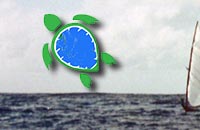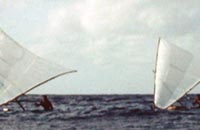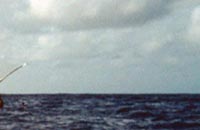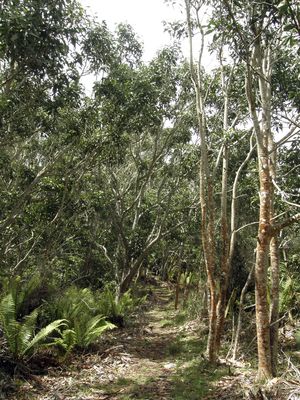|
|
|
|
Part 2: |
June 04, 2013
You may be surprised to learn—as I was—that most of the Hawaiian gods associated with canoe building are forest gods. It makes sense when you think about it. The canoe is a product of the forest, involving many different plant materials, that then takes you out on the sea. In his excellent book The Hawaiian Canoe (Editions Limited, 1981), Tommy Holmes identifies about 20 different gods and goddesses of the canoe. Most of them are forms of Kū, god of the upper forest (among other things), where the tree would come from. Some gods are specific to certain parts of the canoe (like the seat braces), and some for the dangerous task of getting the roughed-out log down from the heights (Holmes, p. 31). Building a canoe was undertaken by a kahuna kālai wa‘a, a canoe-carving expert. The word kahunarefers to experts in all the arts and sciences. This kahuna would make offerings and pray before letting his dreams tell him whether it was auspicious to go into the forest in search of a tree. If the signs were positive, he and his team would provision themselves for the journey up into the mountains, sometimes simply to find and mark a tree for later, other times to fell the tree. The tree of choice in the Hawaiian Islands is known as the koa (Acacia koa). In Holmes’s description: “The islands were blessed with extensive forests of what would come to be called koa, trees of extraordinary size that were found nowhere else in the world. These trees would provide wood of remarkable durability out of which the Hawaiian would shape his canoes.” |
||
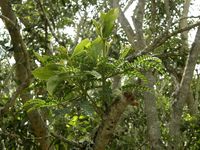
|
||
|
At the time of Cook’s visit in 1779, Lt. Charles Clerke reported: “Some of our Explorers in the woods measured a tree 19 feet in girth and rising very proportionably [sic] in its bulk to a great height, nor did this far, if at all, exceed in stateliness many of its neighbours; we never before met with this kind of wood” (Holmes, p. 17). Holmes goes on to point out that there was considerable difference among koa stands and even from one tree to the next, and that canoe builders had terms (he lists 21) for different types the builders identified (Holmes, p. 23). Other woods used for canoes included wiliwili, kukui (candlenut), and ‘ulu (breadfruit). Softer and lighter than koa, these were used mostly for small “play” or training canoes, and for women's canoes. Lighter woods were considered more vulnerable to the occasional shark attack. A lot of other woods and plant products are used in making the canoe, and I will get to those in time. Now the prime koa forests were located between around 4000 and 6000 feet elevation, and Hawaiians lived pretty much at sea level. So it was a journey of at least five miles, and perhaps as far as 25 miles, to get the tree. And in pre–Captain Cook times, there were no draft animals to pull the log, so it was all human labor. On lava rock. With bare feet. |
||
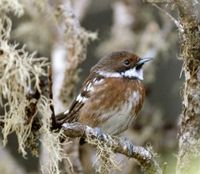
A female volcano ‘elepaio, today the most common subspecies of Hawaiian ‘elepaio. Photo by Eike Wulfmeyer, Keauhou Bird Conservation Center (KBCC), Volcano, Hawai‘i. Used with permission. |
||
|
Once an apparently suitable tree was found, it was up to the goddess Lea, in the form of an ‘elepaio bird (Chasiempis sandwichensis), to indicate the soundness of the log. Martha Beckwith, in her book Hawaiian Mythology, writes: "When a canoe was to be built, a priest would go to the forest, select a tree, and pray to the gods of the woods to bless it, then wait for an ‘elepaio bird to alight on its trunk. If it merely ran up and down, the trunk was sound; but where it stopped to pick at the bark, that spot was sure to be found rotten and the builder would run a risk in making use of the trunk" (Beckwith, p. 91). If the tree passed the bird test, then offerings were made at the base of the tree to the gods, with prayers, a small black pig, coconut, red fish, and ‘awa (piper methysticum), a ceremonial beverage more commonly known as kava or kavakava. For a bigger and more important canoe for a noted chief, a human sacrifice might be deemed necessary. Then the kahuna kālai wa‘a would make one last prayer to his personal guardian spirit (‘aumakua) before making the first blow with his adze. In another post I’ll talk about the stone tools used. For now, suffice it to say that it could take days to cut the tree down. No such elaborate effort or ritual in my case, though I am careful to be respectful and speak kindly to my materials. For the Melanesia canoe, I harvested two 4-by-8-foot sheets of quarter-inch marine plywood from the folks at Chesapeake Light Craft in Annapolis, Maryland. The guys there have been wonderfully helpful in giving me tips and information. No bird was involved. I just tied the sheets to the roof of a Subaru Forester and hoped the wind didn’t rip them in half as I zoomed home up the highway. The 60-mile, round-trip journey took about two hours all together. I didn’t pack any provisions.
|
||
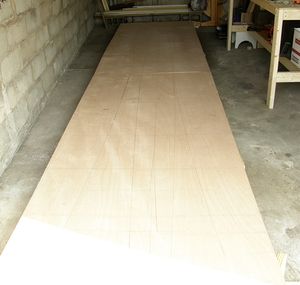
Two 4-by-8-foot sheets of marine plywood will substitute for a koa tree. |
||
|
This plywood is mighty thin stuff. It’s made from okoumé or gaboon (Aucoumea klaineana), a tree grown sustainably in Gabon, Africa, and known for its tall, straight trunks. Here is a picture of my “canoe log.” You will see that the two sheets are laid end to end. This makes for the 16-foot length of the canoe. I have already marked where to cut, but that story comes in the next post. I’m glad to have this material available and hope that the okoumé farms in Africa truly do not come at the cost of native ecosystems. Unfortunately for Hawai‘i, the great stands of koa trees were largely destroyed by human activity, introduced cattle, and introduced pests. Finding a koa log large enough and of good enough quality to carve a big canoe these days is almost impossible, though smaller koa canoes are being made. I have no elaborate ritual, but before we start carving, let me give thanks to the trees who provided this wood, to the land that supported them while they grew, and to the people who tended them. —RDK Herman Next: Part 3: Roughing out the hull
|
||

|
||
Copyright 2016, Pacific Worlds & Associates |
